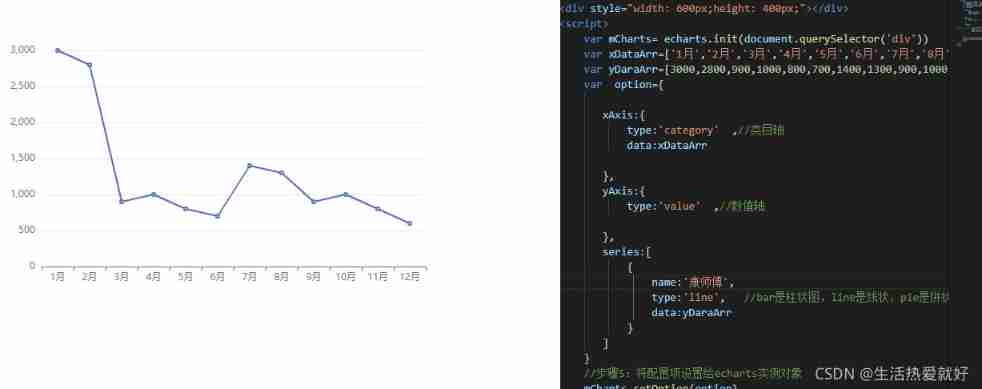当前位置:网站首页>How does Matplotlib generate multiple pictures in turn & only save these pictures without displaying them in the compiler
How does Matplotlib generate multiple pictures in turn & only save these pictures without displaying them in the compiler
2022-07-08 01:26:00 【Bosong】
Catalog
1. Introduction to import library
2. Image generation code introduction
1. Introduction to import library
import os
import inspect
import pandas as pd
import numpy as np
from datetime import datetime
# stay jupyter notebook Display image in
import matplotlib.pyplot as plt
%matplotlib inline
# Show Chinese in the picture 、 Minus sign, etc
plt.rcParams['font.sans-serif']=['SimHei']
plt.rcParams['axes.unicode_minus']=False
import matplotlib
# stay Python The generated image is not displayed in
matplotlib.use('Agg')Before the first part 5 Libraries involve data processing , The second part jupyter notebook Specific settings , The third part is about Chinese drawing names 、 Display of legend and minus sign , The fourth part focuses on the generated multiple pictures 、 Not displayed in the compiler .
2. Image generation code introduction
# Variable initialization settings
emer_sort = pd.DataFrame(columns = ['STARTTIME','WEEK','TIME','MINUTE','BELONGEDLINE','STATIONNAMES'])
# Classify according to a column of data
emer_stagroup = emer.groupby('STATIONNAMES')
# Count effective data days k, Prepare for drawing multiple subgraphs
k = 0
for sta_name, sta_group in emer_stagroup:
# according to STARTTIME Column sorting
emer1 = sta_group.sort_values(by = 'STARTTIME')
emer_timegroup = emer1.groupby('TIME')
for time_name, time_group in emer_timegroup:
# Select a date with sufficient sample size TIME - 5min Spaced samples ,192 yes 16 Hours
if time_group.shape[0] < 192:
continue
else:
# Add all sample points for a day
emer_sort = emer_sort.append(time_group)
k = k + 1
# longitudinal 、 Horizontal axis data
time_group_flow = time_group['FLOW']
time_group_minute = time_group['MINUTE'].to_list()
fig, ax = plt.subplots(figsize = (10, 7))
# Axis scale font settings
plt.tick_params(labelsize=13)
ax.plot(time_group_flow.values)
# Axis title settings
ax.set_xlabel('Date-time', fontsize=14)
ax.set_ylabel('Flow', fontsize=14)
# Title Setting
ax.set_title(time_group['STATIONNAMES'].values[0], fontsize=14)
# Abscissa scale setting - How to display the date
dates = pd.to_datetime(time_group['MINUTE'])
dates = dates.apply(lambda d: d.strftime('%H:%M'))
ax.set_xticks(np.arange(len(dates))[12::24])
# Abscissa scale from 12 The number begins 、 every other 24 The number shows , tilt 45°
_ = ax.set_xticklabels(dates[12::24], rotation=45)
# Storage
plt.savefig('./fig/fig_lots/flow_%s.png'%k, dpi=200)
# Reset dataframe The line of label , and drop The previous label
emer_sort_set = emer_sort.reset_index(drop = True)If the program reports an error “Out of bounds Datetime: Out of bounds nanosecond timestamp: ...”, And point to this line of code dates = pd.to_datetime(time_group['MINUTE']), The current solution is to Comment out this line and the following line .( The question is Another article Some discussion , But there is no conclusion >_<)
Welcome to exchange and discuss ~
边栏推荐
- ROS 问题(topic types do not match、topic datatype/md5sum not match、msg xxx have changed. rerun cmake)
- USB type-C docking design | design USB type-C docking scheme | USB type-C docking circuit reference
- Call (import) in Jupiter notebook ipynb . Py file
- Taiwan Xinchuang sss1700 latest Chinese specification | sss1700 latest Chinese specification | sss1700datasheet Chinese explanation
- Chapter 16 intensive learning
- Matlab code on error analysis (MAE, MAPE, RMSE)
- High quality USB sound card / audio chip sss1700 | sss1700 design 96 kHz 24 bit sampling rate USB headset microphone scheme | sss1700 Chinese design scheme explanation
- Redis集群
- Transportation, new infrastructure and smart highway
- 2022 tea master (intermediate) examination questions and tea master (intermediate) examination skills
猜你喜欢

4. Strategic Learning

2、TD+Learning

2022 safety officer-a certificate free examination questions and safety officer-a certificate mock examination

2022 R1 fast opening pressure vessel operation test question bank and R1 fast opening pressure vessel operation free test questions

2022 safety officer-c certificate examination paper and safety officer-c certificate simulated examination question bank

2022 chemical automation control instrument examination summary and chemical automation control instrument simulation examination questions

Basic realization of line graph

Understanding of maximum likelihood estimation

5、離散控制與連續控制

Several frequently used OCR document scanning tools | no watermark | avoid IQ tax
随机推荐
Gnuradio transmits video and displays it in real time using VLC
Running OFDM in gnuradio_ RX error: gr:: Log: info: packet_ headerparser_ b0 - Detected an invalid packet at item ××
Matlab code on error analysis (MAE, MAPE, RMSE)
Smart grid overview
2022 safety officer-a certificate free examination questions and safety officer-a certificate mock examination
break net
The solution of frame dropping problem in gnuradio OFDM operation
Gnuradio3.9.4 create OOT module instances
Blue Bridge Cup embedded (F103) -1 STM32 clock operation and led operation method
Swift get URL parameters
130. Surrounding area
Kafka-connect将Kafka数据同步到Mysql
A little experience from reading "civilization, modernization, value investment and China"
Smart agricultural technology framework
2. Nonlinear regression
Taiwan Xinchuang sss1700 latest Chinese specification | sss1700 latest Chinese specification | sss1700datasheet Chinese explanation
Kindle operation: transfer downloaded books and change book cover
STM32GPIO口的工作原理
Complete model training routine
2022 tea master (intermediate) examination questions and tea master (intermediate) examination skills